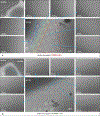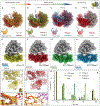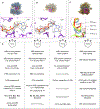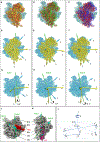Time resolution in cryo-EM using a PDMS-based microfluidic chip assembly and its application to the study of HflX-mediated ribosome recycling
- PMID: 38244547
- PMCID: PMC10872292
- DOI: 10.1016/j.cell.2023.12.027
Time resolution in cryo-EM using a PDMS-based microfluidic chip assembly and its application to the study of HflX-mediated ribosome recycling
Abstract
The rapid kinetics of biological processes and associated short-lived conformational changes pose a significant challenge in attempts to structurally visualize biomolecules during a reaction in real time. Conventionally, on-pathway intermediates have been trapped using chemical modifications or reduced temperature, giving limited insights. Here, we introduce a time-resolved cryo-EM method using a reusable PDMS-based microfluidic chip assembly with high reactant mixing efficiency. Coating of PDMS walls with SiO2 virtually eliminates non-specific sample adsorption and ensures maintenance of the stoichiometry of the reaction, rendering it highly reproducible. In an operating range from 10 to 1,000 ms, the device allows us to follow in vitro reactions of biological molecules at resolution levels in the range of 3 Å. By employing this method, we show the mechanism of progressive HflX-mediated splitting of the 70S E. coli ribosome in the presence of the GTP via capture of three high-resolution reaction intermediates within 140 ms.
Keywords: HflX; microfluidics; recycling; ribosome; short-lived intermediates; single-particle cryo-EM; time-resolved cryo-EM; translation.
Copyright © 2023 Elsevier Inc. All rights reserved.
Conflict of interest statement
Declaration of interests Columbia University has filed patent applications related to this work for which X.F. and J.F. are inventors.
Figures






Update of
-
Time resolution in cryo-EM using a novel PDMS-based microfluidic chip assembly and its application to the study of HflX-mediated ribosome recycling.bioRxiv [Preprint]. 2023 Jul 29:2023.01.25.525430. doi: 10.1101/2023.01.25.525430. bioRxiv. 2023. Update in: Cell. 2024 Feb 1;187(3):782-796.e23. doi: 10.1016/j.cell.2023.12.027. PMID: 36747778 Free PMC article. Updated. Preprint.
Similar articles
-
A PDMS-based Microfluidic Chip Assembly for Time-Resolved Cryo-EM (TRCEM) Sample Preparation.Bio Protoc. 2025 Feb 20;15(4):e5193. doi: 10.21769/BioProtoc.5193. eCollection 2025 Feb 20. Bio Protoc. 2025. PMID: 40040794 Free PMC article.
-
Time resolution in cryo-EM using a novel PDMS-based microfluidic chip assembly and its application to the study of HflX-mediated ribosome recycling.bioRxiv [Preprint]. 2023 Jul 29:2023.01.25.525430. doi: 10.1101/2023.01.25.525430. bioRxiv. 2023. Update in: Cell. 2024 Feb 1;187(3):782-796.e23. doi: 10.1016/j.cell.2023.12.027. PMID: 36747778 Free PMC article. Updated. Preprint.
-
HflX-mediated drug resistance through ribosome splitting and rRNA disordering in mycobacteria.Proc Natl Acad Sci U S A. 2025 Feb 11;122(6):e2419826122. doi: 10.1073/pnas.2419826122. Epub 2025 Feb 6. Proc Natl Acad Sci U S A. 2025. PMID: 39913204 Free PMC article.
-
The Black Book of Psychotropic Dosing and Monitoring.Psychopharmacol Bull. 2024 Jul 8;54(3):8-59. Psychopharmacol Bull. 2024. PMID: 38993656 Free PMC article. Review.
-
123I-MIBG scintigraphy and 18F-FDG-PET imaging for diagnosing neuroblastoma.Cochrane Database Syst Rev. 2015 Sep 29;2015(9):CD009263. doi: 10.1002/14651858.CD009263.pub2. Cochrane Database Syst Rev. 2015. PMID: 26417712 Free PMC article.
Cited by
-
Efficient high-resolution refinement in cryo-EM with stochastic gradient descent.Acta Crystallogr D Struct Biol. 2025 Jul 1;81(Pt 7):327-343. doi: 10.1107/S205979832500511X. Epub 2025 Jun 23. Acta Crystallogr D Struct Biol. 2025. PMID: 40548951 Free PMC article.
-
Mechanistic insights into the alternative ribosome recycling by HflXr.Nucleic Acids Res. 2024 Apr 24;52(7):4053-4066. doi: 10.1093/nar/gkae128. Nucleic Acids Res. 2024. PMID: 38407413 Free PMC article.
-
Real-Time Observation of Polymer Fluctuations During Phase Transition Using Transmission Electron Microscope.Polymers (Basel). 2025 Jan 23;17(3):292. doi: 10.3390/polym17030292. Polymers (Basel). 2025. PMID: 39940500 Free PMC article.
-
Switching Go̅-Martini for Investigating Protein Conformational Transitions and Associated Protein-Lipid Interactions.J Chem Theory Comput. 2024 Mar 26;20(6):2618-2629. doi: 10.1021/acs.jctc.3c01222. Epub 2024 Mar 6. J Chem Theory Comput. 2024. PMID: 38447049 Free PMC article.
-
A PDMS-based Microfluidic Chip Assembly for Time-Resolved Cryo-EM (TRCEM) Sample Preparation.Bio Protoc. 2025 Feb 20;15(4):e5193. doi: 10.21769/BioProtoc.5193. eCollection 2025 Feb 20. Bio Protoc. 2025. PMID: 40040794 Free PMC article.
References
Publication types
MeSH terms
Substances
Grants and funding
LinkOut - more resources
Full Text Sources

